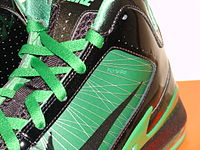Nike Flywire
 Close up image of the Flywire on an Air Max 'Hyperfly Supreme' | |
| Type | Yarn used in sneakers |
|---|---|
| Inventor | Jay Meschter |
| Inception | 2008 |
| Manufacturer | Nike, Inc. |
| Website | nike.com/flywire |
Nike Flywire is a thread, composed of vectran or nylon, developed by Nike to minimize weight and maximize support, and used in the upper part of a sneaker. Shoes containing Flywire became available for consumer purchase in 2008.[1]
Development
Flywire was created by Jay Meschter, Director of Innovation at Nike.[2] He began by taking a foot last and marking the key points of where a shoe needs to support the foot. When Meschter saw an embroidery machine, he determined the machine could be used to make long stitches. Long stitches allow lightweight fibers to support the foot in key points, instead of using layers of material that support the whole foot.
Nike designed Flywire with inspiration from a
Vectran

Nike adapts
Weight
Due to the Vectran fibers, shoes containing Nike Flywire weigh as little as 93
Shoes
Many Nike shoes contain Flywire.
References
- ^ a b Jones, Riley. "KNOW YOUR TECH: Nike Flywire". Complex.
- ^ a b Resetar, Max (2017-12-18). "Sole Survivors: Kobe Bryant and the Nike Hyperdunk's Legacy". Slam. Retrieved 2023-04-04.
- ^ a b c "Technology >> Flywire > Detail". Nike Lab. Retrieved 2008-10-14.
- ^ a b "Vectran Fiber to Propel Olympic Runners in Revolutionary New Nike Zoom Victory Running Shoes". Marketwire. Retrieved 2008-10-14.
- ^ "Latest materials improve sportswear performance". ICIS Chemical Business. Retrieved 2008-10-14.
- ^ "History of the Nike Flyknit Trainer". Sneaker Breaker.
